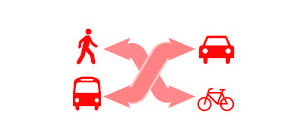Structuring the transit network around rapid transit corridors, increasing transit service, and improving the customer experience are essential to build ridership in anticipation of rapid transit and to position transit as a competitive mobility choice.
The first key contributor to becoming Rapid Ready in Hamilton is to invest in improving transit services and reconfigure the transit network in anticipation of rapid transit. These early investments would increase ridership, elevate the role of public transit in Hamilton, and prepare customers for rapid transit implementation.
Increasing transit ridership in Hamilton should be a key component of a strategy to get Rapid Ready in order to grow the market of transit riders that would be eventual rapid transit users. This ensures that new rapid transit services are well utilized, increases transportation user benefits, and provides a more attractive financial business case for rapid transit investment. While there are many measures to increase transit ridership, the proven approach is to provide more hours of service. Increasing service makes transit more frequent and attractive to riders, with a direct correlation between revenue service hours per capita and transit ridership per capita.
Increasing municipal investment in transit service to build ridership will demonstrate that Hamilton is serious about public transit as a competitive travel choice.
In addition to investing in more service hours, transit can become Rapid Ready by reconfiguring the network to prepare for rapid transit service, by reorienting existing transit services to feed planned rapid transit corridors to establish travel patterns in advance of implementation. Taking a proactive approach to network changes, in conjunction with engagement of impacted communities, will help customers and residents understand, influence, and champion improvements to the transit network.
Finally, getting Rapid Ready means elevating of the role of public transit in Hamilton – making transit a competitive mobility choice that is central to the city’s communities. Currently, there are strong perceptions of public transit in Hamilton as not a choice, but a service relegated only to those who cannot drive. Changing this perception, through a combination of improved service, an enhanced customer experience, marketing, and branding are key to reposition transit as a viable and attractive choice. Giving transit greater priority on streets, making it faster and more reliable, will reinforce transit’s role in keeping Hamilton moving.




